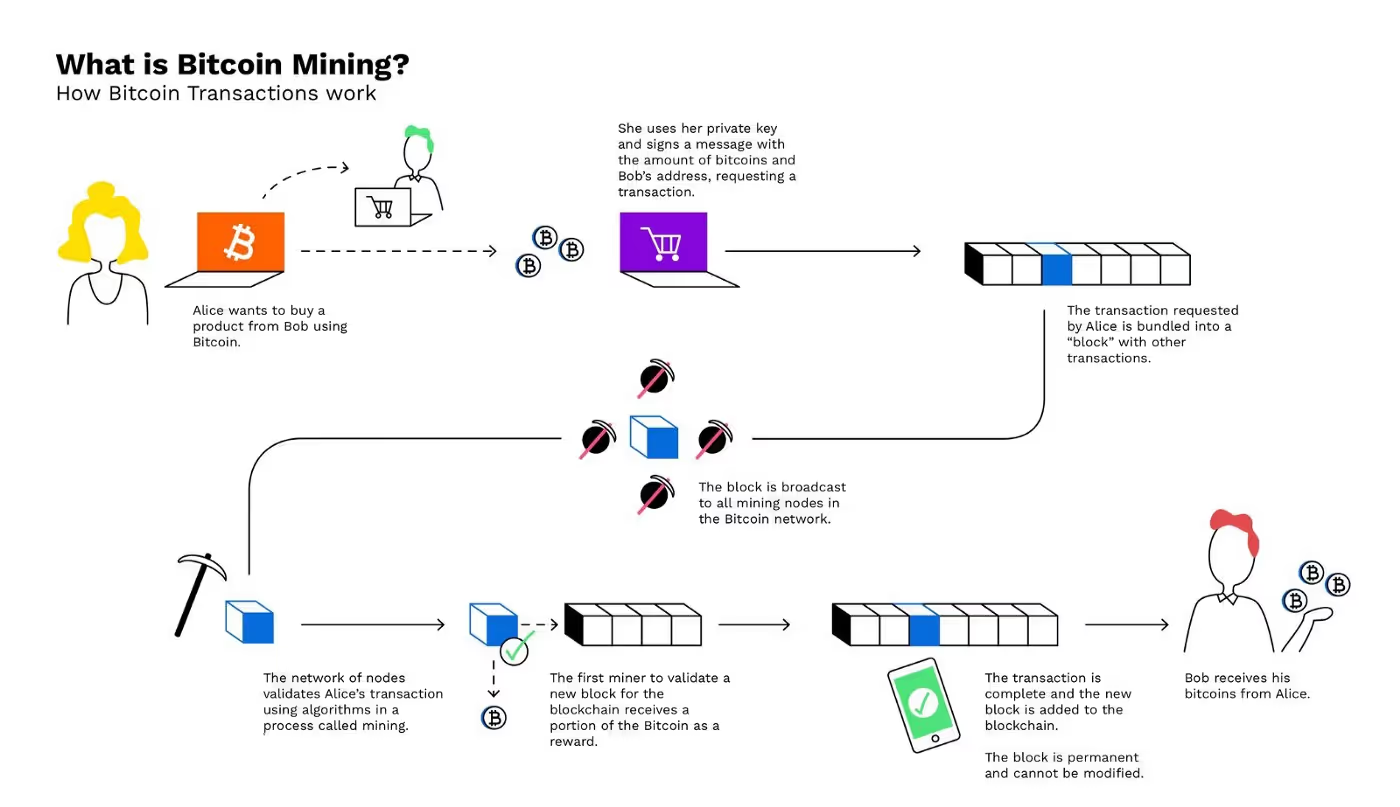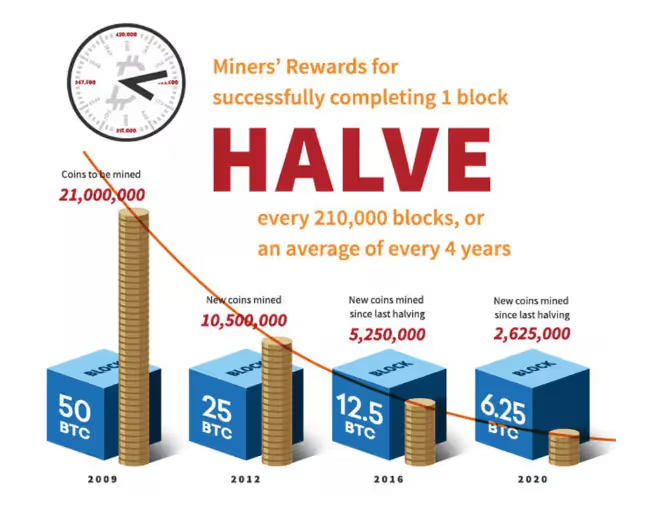
Bitcoin was created in 2009 by an anonymous person(s) who went by the handle Satoshi Nakamoto. The goal was to create a supplemental economy to the existing system we have where all money is free of restrictions from the corruptions and limitations of borders, governments, and societies. The world has become increasingly more digital and the internet has broken down the barrier of communication between countries. Location no longer restricts our ability to contribute and share ideas. However, so far, humans have failed to make our money flow as fluidly as our data. If you’d like to learn more about what Bitcoin is and how it works check out our introductory article.
Bitcoin Halvings
Mining Bitcoin or becoming a Bitcoin Miner has become a bit of a phenomenon as a new way to make side income. But most people don’t really understand what that means. Essentially, every time there is a bitcoin transaction it gets bundled with others into a “block”. There is a new block every 10 minutes and network participants called “miners” compete with each other for the opportunity to be assigned that block. Mining this block requires solving complex algorithms with high powered processors and, once complete, grants the miner(s) a block reward. This reward is currently 12.5 Bitcoin and is cut in half every 4 years. Halvings are very important to Bitcoin and you can learn more about them here!

How Does Bitcoin Mining Work?
- Step 1: A user signs off on a transaction from their Bitcoin wallet, attempting to send their Bitcoin to someone else.
- Step 2: The transaction is broadcasted by the wallet app and is now awaiting to be picked up by a miner on the blockchain. As long as it is not picked up, it hovers in a ‘pool of unconfirmed transactions’.
- Step 3: Miners on the network select transactions from these pools and form them into a ‘block’. A block is basically a collection of transactions and some extra metadata. Every miner constructs their own block of transactions. Multiple miners can select the same transactions to be included in their block.
- Example: Two miners, miner A and miner B. Both miner A and miner B can decide to include transaction X into their block. On the Bitcoin blockchain, the maximum block size of one block is 2MB of data. Before adding a transaction to their block, a miner needs to check if the transaction is eligible to be executed according to the blockchain history. If the sender’s wallet balance has sufficient funds according to the existing blockchain history, the transaction is considered valid and can be added to the block. If a Bitcoin owner wants to speed up their transaction, they can choose to offer a higher mining reward. Miners will usually prioritize such transactions over others, because they provide a better mining reward.
- Step 4: By selecting transactions and adding them to their block, miners create a block of transactions. To add this block of transactions to the blockchain (which means having all the nodes on the blockchain register the transactions in this block), the block first needs a signature (also referred to as a ‘proof of work’). This signature is created by solving a very complex mathematical problem that is unique to each block of transactions. Each block has a different mathematical problem, so every miner will work on a different problem unique to the block they formed. Each block’s problem is equally hard to solve. In order to solve this mathematical problem, a lot of computational power is used (and a lot of electricity). You can compare it to running a calculation on a calculator, only this is much heavier and done on a computer. This is the process referred to as mining.
- Step 5: Now that the miner has found the correct signature for its block, they broadcast this block and its signature to all the other miners.
- Step 6: Other miners now verify the signature’s legitimacy by taking the string of data of the broadcasted block, and hashing it to see if its hash output indeed leads to its included signature with the correct number of zeros. Unlike solving for the signature as described in step 4 above, this verification step is easy. If it is valid, the other miners will confirm the signature’s validity and agree that the block can be added to the blockchain. This is where the term “Consensus” in “Consensus Algorithm” comes from, the miners all agree with each other. Likewise, the ‘proof of work’ comes from the signature being the ‘proof’ of the work performed. At this point the block can be added to the blockchain, and is distributed to all other nodes on the network. The other nodes will accept the block and save it to their transaction data so long as all transactions inside the block can be executed according to the blockchain’s history.
- Step 7: After a block has been added to the chain, every other block that is added on top of it counts as a ‘confirmation’ for that block. For example, if your transaction is included in block 502, and the blockchain is 507 blocks long, it means your transaction has 5 confirmations (507–502). It is referred to as a confirmation because every time another block is added on top of the block your transaction is in, the blockchain reaches consensus again on the complete transaction history, including your transaction and your block. In other words, your transaction has been confirmed 5 times by the blockchain at that point. The more confirmations your transaction has, the deeper the block is embedded in the chain. As a result it’s harder for attackers to alter the block (read about how this works here). After a new block is added to the blockchain, all miners need to start over again at step three by forming a new block of transactions.
Final Thoughts
We know that the concept of Bitcoin Mining can seem a bit complicated. We hope this has been helpful. As consultants to some of the most knowledgeable crypto mining teams we’ve learned there are sometimes gaps in knowledge that we’re happy to clear up. If you have any questions, we’re always happy to field them via email, in the comments below, or on social media. At this point you should have a better understanding of the basic terms surrounding mining and have a sense of how Bitcoin Mining really works.
Stay Tuned
Thanks for reading! Sazmining is the leading US based operation that offers a 360 approach to cryptocurrency through joint venture crypto mining projects, consulting services and treasury management to help our partners and investors navigate the financial aspects of cryptocurrency management. Our team has built and scaled a wide range of mining operations in locations as diverse as China, Texas, and Iceland. We are well positioned to offer a range of services to new entrants to the industry, or established players looking to expand.
There’s a lot of growing pains with nascent industries such as blockchain and digital assets, but the core of the problem lies around the lack of education. Our goal is to help make things easier to understand. Please follow our twitter, like our LinkedIn, and share this article with a curious bitcoin miner.

